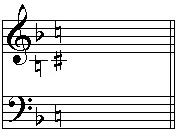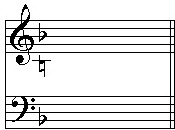|
The pieces on this site use two basic tunings, which I call Antico and Moderno, after the Passamezzo Antico and Passamezzo Moderno, two important harmonic/metric schemes of the sixteenth century. The Antico tuning is similar to the modern harmonic minor: the third, sixth, and seventh scale degrees above the final (or tonic) are minor; the intervals descending from the final are a semitone and then a whole tone. (In other words, a major sixth and major seventh leading up to the final, and a natural minor scale ascending from the final.) For example, the D-Antico tuning looks like this:
The Moderno tuning feels like the modern major scale with a flatted seventh in the bass. It comes in two forms: Moderno-1, which has a minor seventh above the final; and Moderno-2, which has a major seventh above the final. This is the C-Moderno-1 tuning:
Both of these schemes make possible (with careful choice of voicing) major triads on both the seventh scale degree (C major in D-Antico; B-flat major in C-Moderno) and the fifth scale degree (A major in D-Antico; G-major in C-Moderno). The juxtaposition of these sonorities is an distinctive feature of sixteenth-century music. Click Here for a detailed description of each tuning. |

